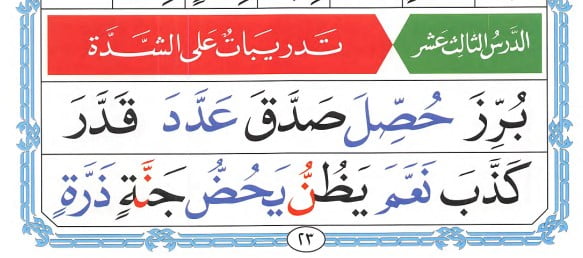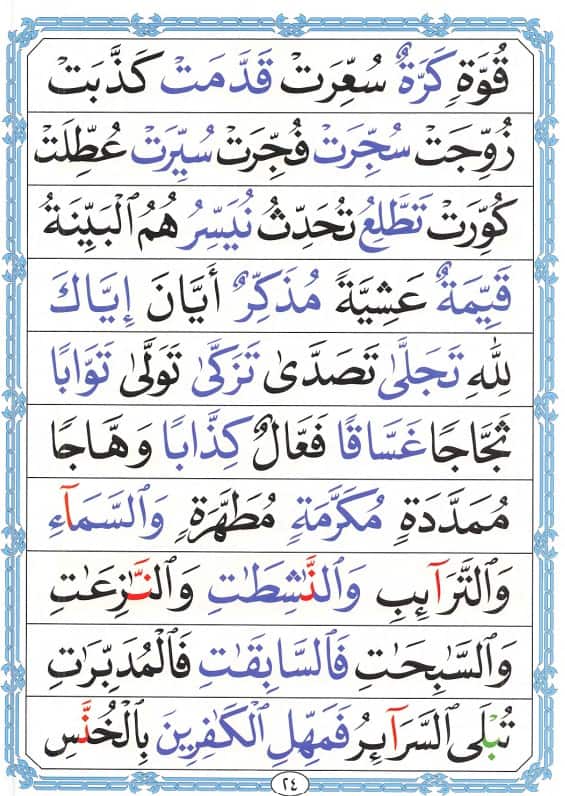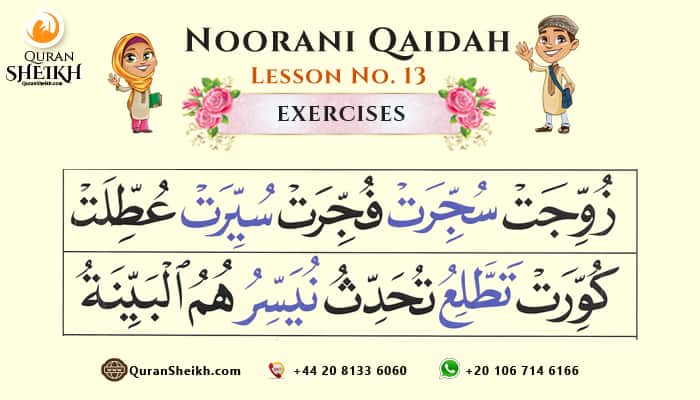Noorani Qaida Lesson 13: Master Shaddah (ــّـ) in Quranic Arabic – Practice Doubled Letters Like a Pro!
Welcome to Noorani Qaida Lesson 13, where you’ll master Shaddah (Tashdeed) through practical exercises!
Perfect for beginners and learners, these drills improve your Quran recitation fluency. Learn tips like pronouncing ‘ر’ with Shaddah correctly and saying Allah’s name lightly with Kasrah.
Noorani Qaida lesson 13 Video:
Learn Shaddah with Noorani Qaida Lesson 13 exercises. Practice Tashdeed for flawless Quran recitation with examples and Tajweed tips. Start improving today!
Join thousands of Muslim Families who love learning Noorani Qaida & Quran reading from the comfort of their Homes.
Noorani Qaida page 23

بُرِّزَ : read it as “ba dammah ra shaddah burr, ra kasrah ri, burrri, za fathah za, burrriza”.
حُصِّلَ : read it as “ha dammah Sad shaddah huss, Sad kasrah Si, hussSi, lam fathah la, hussSIla”.
صَدَّقَ : read it as “Sad fathah dal shaddah Sadd, dal fathah da, Saddda, qaf fathah qa, Sadddaqa”.
عَدَّدّ : read it as “ayeen fathah dal shaddah a’add, dal fathah da, a’addda, dal fathah da, a’adddada”.
قَدَّرَ : read it as “qaf fathah dal shaddah qadd, dal fathah da, qaddda, ra fathah ra, qadddara”.
كَدَّبَ : read it as “kaf fathah zal shaddah kazz, zal fathah za, kazzza, ba fathah ba, kazzzaba”.
نَعَّمَ : read it as “noon fathah ayeen shaddah na’a, ayeen fathah a’a, na’aa’a, meem fathah ma, na’aa’ama”.
Precaution : do not read ayeen with a jerk. Try to pronounce this ayeen smoothly.
The red letters in this lesson are special letters. They follow some special rules which is about noon and meem shaddah letters. These letters cannot be pronounced without nose. So, the letters noon and meem sounds need the nasal echo or nasal cavity.
Whenever the letters noon and meem come with shaddah, make Ghunnah. Ghunnah is the nasal sound held for the two harakat. You need to hold the sound in nose for two harakats.
يَظُنُّ : read it as “ya fathah ya, Za dammah noon shaddah Zun, yaZun, noon dammah nu, yaZunnnu ”.
يَحُضُّ : read it as “ya fathah ya, ha dammah Zad shaddah huZZ, yahuZZ, Zad dammah Zu, huZZZu”.
جَنَّةٍ : read it as “jeem fathah noon shaddah jan, noon fathah na, jan’nna, ta kasratain tin, jan’nnatin”.
ذَرَّةٍ : read it as “zal fathah ra shaddah zarr, ra fathah ra, zarrra, ta kasratain tin, zarrratin”.
Precaution : when ra has shaddah on it, then don’t repeat it while pronouncing rather to hold the ra sound. The tongue should be suspended while pronouncing it.
Learn Quran Online fast and easy with a Qualifies Arab teacher, Get 30% OFF join now.
Noorani Qaida lesson 13
Noorani Qaida page 24

قُوَّةٍ : read it as “qaf dammah waao shaddah quvv, waao fathah wa, quvvwa, ta kasratain tin, quvvwatin”.
كَرَّةٌ : read it as “kaf fathah ra shadda karr, ra fathah ra, karrra, ta dammatain tun, karrratun”.
سُعِّرَتۡ : read it as “seem dammah ayeen shaddah su’u, ayeen kasrah e’e, su’ue’e, ra fathah ta rat, su’ue’erat,”.
قَدَّمَتۡ : read it as “qaf fathah dal shaddah qadd, dal fathah da, qaddda, meem fathah ta mat, qadddamat”.
كَذَّبَتۡ : read it as “kaf fatha zal shaddah kazz, zal fathah za, kazzza, ba fathah ta bat, kazzzabat”.
زُوِّجَتۡ : read it as “za dammah waao shaddah zuvv, waao kasrah wi, zuvvwi, jeem fathah ta jat, zuvvwijat”.
سُجِّرَتۡ : read it as “seen dammah jeem shaddah sujj, jeem kasrah ji, sujjji, ra fathah ta rat, sujjjirat”.
فُجِّرَتۡ : read it as “fa dammah jeem shaddah fujj, jeem kasrah ji, fujjji, ra fathah ta rat, fujjjirat”.
سُيِّرَتۡ : read it as “seen dammah ya shaddah su’ui, ya kasrah yi, suuyi, ra fathah ta rat, suuyirat”.
عُطِّلَتۡ : read it as “ayeen dammah Ta shaddah u’uTT, Ta kasrah Ti, u’uTTTi, lam fathah ta lat, u’uTTTilat”.
كُوِّرَتۡ : read it as “kaf dammah waao shaddah kuvv, waao kasrah wi, kuvvwi, ra fathah ta rat, kuvvwirat”.
تَطِّلِعُ : read it as “ta fathah Ta shaddah taTT, Ta fathah Ta, taTTTa, lam kasrah li, taTTTili, ayeen dammah u’u, taTTTiliu’u”.
تُحَدِّثُ : read it as “ta damma tu, ha fathah dal shaddah hadd, tuhadd, dal kasrah di, tuhadddi, sa dammah su, tuhadddisu”.
نُيَسِّرُ : read it as “noon dammah nu, ya fathah seen shaddah yass, nuyass, seen kasrah si, nuyasssi, ra dammah ru, nuyasssiru”.
هُمُ اؐلۡبَيِّنَةُ : read it as “Ha dammah Hu, meem dammah lam mul, Humul, ba fathah ya shaddah by’yy, Humulby’yy, ya kasrah yi, Humulby’yyi, noon fathah na, Humulby’yyina, ta dammah tu, Humulby’yyinatu ”.
قَيِّمَةٌ : read it as “qaf fathah ya shaddah qay’yy, ya kasrah yi, qay’yyi, meem fathah ma, qay’yyima, ta dammatain tun, qay’yyimatun”.
عَشِيِّةً : read it as “ayeen fatah a’a, sheen kasrah ya shaddah shi’yy, a’ashi’yy, ya fathah ya, a’ashi’yyya, ta fatahatain tan, a’ashi’yyyatan”.
مُذَكِّرٌ : read it as “meem dammah mu, zal fathah kaf shaddah zakk, muzakk, kaf kasrah ki, muzakkki, ra dammatain run, muzakkkirun”.
أَيَّانَ : read it as “hamzah fathah ya shaddah a’yy, ya fathah alif ya, a’yyya, noon fatahh na, a’yyyana”.
إِيَّاكَ : read it as “hamzah kasrah ya shaddah i’yy, ya fathah alif ya, i’yyya, kaf fathah ka, i’yyyaka”.
لِلَّٰهِ : read it as “lam kasrah lam shaddah lill, lam fathah alif laa, lilllaa, Ha kasrah Hi, lillaaHi”.
Note : this is the name of Allah here it means for Allah. Usually, when we read the name of Allah we make it heavy but here we made it light by saying LillaaHi. This is because when the name of Allah Almighty is preceded by a kasrah it will be pronounced lightly otherwise it is pronounced as a heavy letter.
تَجَلَّىٰ : read it as “ta fathah ta, jeem fathah lam shaddah jall, tajall, lam fathah alif laaa, tajallla”.
تَصَدَّىٰ : read it as “ta fathah ta, Sad fathah dal shaddah Sadd, taSadd, dal fatha alif daa, taSadddaa”.
تَزَكَّىٰ : read it as “ta fatha ta, za fatha kaf shaddah zakk, tazakk, kaf fathah alif kaa, tazakkkaa”.
تَوَلَّىٰ : read it as “ta fathah ta, waao fathah lam shaddah wall, tawall, lam fathah alif laa, tawalllaa”.
تَوَّابًا : read it as “ta fathah waao shaddah tavv, waao fathah alif laa, tavvlaa, ba fatahatain ban, tavvwaaban”.
ثَجَّاجًا : read it as “sa fathah jeeem shaddah sajj, ja fathah alif jaa, sajjjaa, jeem fatahatain jan, sajjjajan”.
غَسَّاقًا : read it as “ghayeen fathah seen shaddah ghass, seen fathah alif saa, ghasssaa, qaf fatahatain qan, ghasssaaqan”.
فَعَّالٌ : read it as “fa fathah ayeen shaddah fa’a, ayeen fathah alif a’aa, fa’aaa, lam dammatain lun, fa’aaalun”.
كِذَّابًا : read it as “kaf kasrah zal shaddah kizz, zal fathah alif zaa, kizzzaa, ba fatahatain ban, kizzzaban”.
وَهَّاجًا : read it as “waao fathah Ha shaddah waHH, Ha fathah alif Haa, waHHHaa, jeem fatahatain jan, waHHHaajan”.
مُمَدَّدَةٍ : read it as “meem dammah mu, meem fathha dal shaddah madd, mumadd, dal fathah da, mumaddda, dal fathah da, mumadddada, ta kasratain tin, mumadddadatin”.
مُكَرَّمَةٍ : read it as “meem dammah mu, kaf fathah ra shaddah karr, mukarr, ra fathah ra, mukarrra, meem fathah ma, mukarrrama, ta kasratain tin, mukarrramatin”.
مُطَهَّرَةٍ : read it as “meem dammah mu, Ta fathah Ha shaddah taHH, muTaHH, Ha fathah Ha, muTaHHHa, ra fathah ra, mutaHHara, ta kasratain tin, mutaHHaratin”.
وَاؐلسَّمَآءِ : read it as “waao fathah seen shaddah wass, seen fathah sa, wasssa, meem fathah alif maa, wasssamaa, hamzah kasrah e, wasssamaaaae”.
وَاؐلتَّرَآءِبِ : read it as “waao fathah ta shaddah watt, ta fathah ta, wattta, ra fathah alif raa, watttaraa, hamzah kasrah e, watttaraae, ba kasrah bi, watttaraaebi”.
وَاؐلنَّٰشِطَٰتِ : read it as “waao fathah noon shaddah wann, noon fathah alif naa, wannnaa, sheen kasrah shi, wannnaashi, Ta fathah alif Taa, wannnaashiTaa, ta kasrah ti, wannnaashiTaati”.
وَاؐلنَّـٰزِعَـٰتِ : read it as “waao fathah noon shaddah wann, noon fathah alif naa, wannnaa, za kasrah zi, wannnaazi, ayeen fathah alif a’aa, wannnaazia’aa, ta kasrah ti, wannnaazia’aati”.
وَاؐلسَّـٰبِحـٰتِ : read it as “waao fathah seen shaddah wass, seen fathah alif saa, wasssaa, ba kasrah bi, wasssaabi, ha fathah alif haa, wasssaabihaa, ta kasrah ti, wasssaabihaati”.
فَاؐلسَّابِقَـٰتِ : read it as “fa fathah seen shaddah fass, seen fathah alif saa, fasssaa, ba kasrah bi, fasssaabi, qaf fathah alif qaa, fasssaabiqaa, ta kasrah ti, fasssaabiqaati”.
فَاؐلۡمُدَبِّرَٰتِ : read it as “fa fathah lam fal, meem dammah mu, falmu, dal fathah ba shaddah dabb, falmudabb, ba kasrah bi, falmudabbbi, ra fathah alif raa, falmudabbbiraa, ta kasrah ti, falmudabbbiraati”.
تُبۡلَى اؐلسَّرَآءِرُ : read it as “ta dammah ba tubb, lam fathah seen shaddah lass, tubblass, seen fathah sa, tubblasssa, ra fathah alif raa, tubblasssaraa, hamzah kasrah e, tubblasssaraae, ra dammah ru, tubblasssaraaeru”.
فَمَهِّلِ اؐلۡكَـٰفِرِينَ : read it as “fa fathah fa, meem fathah Ha shaddah maHH, famaHH, Ha kasrah Hi, famaHH’Hi, lam kasrah lam lil, famaHH’Hilil, kaf fathah alif kaa, famaHH’Hililkaa, fa kasrah fi, famaHH’Hililkaafi, ra kasrah ya ree, famaHH’Hililkaafiree, noon fathah na, famaHH’Hililkaafireena ”.
بِاؐلۡخُنَّسِ اؐلۡجَوَارِاؐلۡكُنَّسِ : read it as “ba kasrah lam bil, kha dammah noon shaddah khun, bilkhun, noon fatha na, bilkhunna, seen kasrah lam si, bilkhunnasil, jeem fathah ja, bilkhunnasilja, waao fatha ali waa, bilkhunnasiljawaa, ra kasrah lam ril, bilkhunnasiljawaaril, kaf dammah noon shaddah kun, bilkhunnasiljawaarilkun, noon fathah na, bilkhunnasiljawaarilkunna, seen kasrah si, bilkhunnasiljawaarilkunnasi”.
Learn Quran Online fast and easy with a Qualifies Arab teacher, Get 30% OFF join now.
Noorani Qaida lesson 13
Noorani Qaida page 25

Before going to learn the pronunciation of the following word, remember that we have already covered the rules of Hamza tul Wasl in lesson no 10. One of rules is that if you begin with Hamza tul Wasl and next letter is lam then you pronounce this hamzah with a fathah. If the next letter is not a lam, then you look at the third letter, if the third letter has a dammah then this hamzah takes the dammah. In all the other cases it takes kasrah. So, if you see here, the next letter after hamzah is not a lam and also the third letter has no dammah. So hamzah will take kasrah here.
اؐهۡدِنَااؐلصِّرَٰطَ اؐلۡمُسۡتَقِيمَ : read it as “hamzah kasrah Ha iHH, dal kasrah di, iHHdi, noon fathah Sad shaddah naSS, iHHdinaSS, Sad kasrah Si, iHHdinaSSSi, ra fathah alif raa, iHHdinaSSSiraa, Ta fathah lam Tal, iHHdinaSSSiraaTal, meem dammah seen mus, iHHdinaSSSiraaTalmus, ta fathah ta, iHHdinaSSSiraaTalmusta, qaf kasrah ya qee, iHHdinaSSSiraaTalmustaqee, meem fathah ma, iHHdinaSSSiraaTalmustaqeema”.
Note: Read all the lesson without Hijja by yourself. If you have not learn to pronounce without Hijja you may be in trouble while reading the Noble Quran.
Noorani Qaida lesson 13
Noorani Qaida PDF:
Download Noorani Qaida Book as a PDF file, please click on download icon.
Noorani Qaida Online Course:
Quran Sheikh Institute provide you Noorani Qaida course Register now and get 25% OFF.
Start noorani qaida lessons and know how to read Arabic Alphabet up to read Quran with Tajweed insha Allah well.
Learn Quran for Kids & Adults – From Beginner to Fluent
Free Trial Lesson – Sign Up Today

FAQs about Noorani Qaida Lesson 13 – Shaddah Exercises
What’s the main goal of Noorani Qaida Lesson 13?
The main goal is to practice Shaddah in words and sentences, reading them fluently without Hijja (spelling out each letter).
What is “Ghunnah” and when is it applied in this lesson?
Ghunnah is a nasal sound held for two counts. Apply it whenever you see noon (نّ) or meem (مّ) with Shaddah.
How do you pronounce Ra (ر) with Shaddah in this lesson?
When Ra has Shaddah (رّ), hold the sound instead of repeating it. Keep your tongue relaxed.
Why is Hamzah Wasl (اؐ) reviewed again in this lesson?
This lesson provides further practice on how to pronounce or skip Hamzah Wasl (اؐ) depending on its position and the surrounding letters.
What’s the rule for Hamzah Wasl (اؐ) before the letter “Lam” (ل)?
If Hamzah Wasl (اؐ) comes before “Lam” (ل), pronounce the Hamzah with a fathah.
What if the letter after Hamzah Wasl (اؐ) is NOT “Lam” (ل)?
Look at the third letter. If it has a dammah, give the Hamzah dammah. Otherwise, give it kasrah.
What’s the most important tip for succeeding in this lesson?
Practice reading all the examples repeatedly without Hijja. This builds Quran reading fluency. If you struggle, review previous lessons.
Noorani Qaida Lesson 13 provides intensive exercises to master Shaddah (doubled letters). It emphasizes reading fluency and applying Ghunnah (nasal sound).
How to read a word with Shaddah correctly?
Pronounce the letter with Shaddah as if saying it twice: once with Sukoon, then with its vowel. Example: بُرِّزَ (Burriza) – say “burr” then add “riza” = Burriza.
How to apply Ghunnah in this lesson’s exercises?
When you see noon (نّ) or meem (مّ) with Shaddah, make Ghunnah by holding the sound in nose for two counts (harakats). Example: جَنَّةٍ (Jannatin) – elongate the “nn” sound nasally.
What does it mean to read “without Hijja”?
Reading “without Hijja” means saying the entire word directly, without spelling out each letter (e.g., not saying “dal fathah da,” but just “da”). The text explicitly mentions that reading without Hijja is important for success.
How to handle Ra (ر) with Shaddah?
When Ra has Shaddah (رّ), hold the sound instead of repeating it. Keep your tongue relaxed. Example: ذَرَّةٍ (Zarratin) – focus on holding the “rr” sound without bouncing it.
How to improve my pronunciation in this lesson?
Practice reading all the examples repeatedly, focusing on accuracy and smoothness. If you struggle, review the previous lesson on Shaddah rules. The lesson emphasizes doing this “without Hijja.”
Explore Previous Lesson:
Shaddah Rules
Noorani Qaida Lesson 12
Master the Next Step:
Shaddah & Sukoon Exercises





